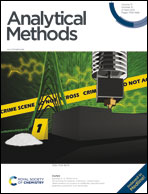Development of a chemiluminescence immunoassay for detection of tenuazonic acid mycotoxin in fruit juices with a specific camel polyclonal antibody†
Abstract
The natural mycotoxin tenuazonic acid (TeA) in foods is identified as the most toxic mycotoxin among the over 70 kinds of secondary toxic metabolites produced by Alternaria alternata. Some hapten–antibody-mediated immunoassays have been developed for TeA detection in food samples, but these methods show unsatisfactory sensitivity and specificity. In this study, a rationally designed hapten for TeA mycotoxin generated with computer-assisted modeling was prepared to produce a highly specific camel polyclonal antibody, and an indirect competitive chemiluminescence enzyme immunoassay (icCLEIA) was established with a limit of detection of 0.2 ng mL−1 under optimized conditions. The cross-reactivity results showed that several analogs and some common mycotoxins had negligible recognition by the anti-TeA polyclonal antibody. The average recoveries spiked in fruit juices were determined to be 92.7% with an acceptable coefficient of variation, and good correlations between icCLEIA and liquid chromatography tandem mass spectrometry (LC-MS/MS) results were obtained in spiked samples. This developed icCLEIA for TeA detection with significantly improved sensitivity and satisfactory specificity is a promising alternative for environmental monitoring and food safety.



 Please wait while we load your content...
Please wait while we load your content...